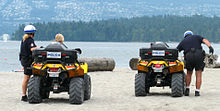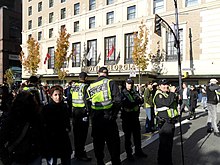|
Vancouver Police Department
The Vancouver Police Department (VPD) (French: Service de police de Vancouver) is the police force in Vancouver, British Columbia, Canada. It is one of several police departments within the Metro Vancouver Area and is the second largest police force in the province after RCMP "E" Division. VPD was the first Canadian municipal police force to hire a female officer and the first to start a marine squad.[2] VPD, along with eleven other BC municipal police forces, seconds officers to the Combined Forces Special Enforcement Unit – British Columbia. VPD now occupies the former Vancouver Organizing Committee for the 2010 Olympic and Paralympic Winter Games (VANOC) building at 3585 Graveley Street, which houses administrative and specialized investigation units.[3][4] HistoryAt the first meeting of Vancouver City Council, Vancouver's first police officer, Chief Constable John Stewart, was appointed on May 10, 1886. On June 14, 1886, the morning after the Great Fire of 1886, Mayor McLean appointed Jackson Abray, V.W. Haywood, and John McLaren as special constables. With uniforms from Seattle and badges fashioned from American coins, this four man team became Vancouver's first police department based out of the City Hall tent at the foot of Carrall Street. These four were replaced in 1887 by special constables sent by the provincial government in Victoria for not keeping the peace during the anti-Asian unrest of that year. The strength of the force increased from four to fourteen as a result.  By 1904, the department had grown to 31 members and occupied a new police building at 200 Cordova Street. In 1912, Vancouver's first two women were taken on the force as matrons. With the amalgamation of Point Grey and South Vancouver with Vancouver in 1929, the department absorbed the two smaller police forces under the direction of Chief Constable W.J. Bingham, a former district supervisor with the Metropolitan Police in London. By the 1940s the department had grown to 570 members.  In 1912, L.D. Harris and Minnie Miller were hired as the first two policewomen in Canada. In 1917, Chief Constable McLennan was killed in the line of duty in a shoot-out in Vancouver's East End. Responding to a call by a landlord attempting to evict a tenant, the police were met by gunfire. Along with McLennan, the shooter was killed in the battle, as was a nine-year-old boy in the vicinity at Georgia and Jackson streets, which is now marked by a mosaic memorial. A detective who lost an eye in the shootout, John Cameron, later became the chief constable of the New Westminster Police Department before taking the top job of the Vancouver force, which he occupied from 1933 to the end of 1934. Another member of the force was killed in the line of duty in 1922. Twenty-three-year-old constable, Robert McBeath, was shot by a man stopped for impaired driving. McBeath had received the Victoria Cross for "most conspicuous bravery" at the Battle of Cambrai in France in the First World War. McBeath's killer, Fred Deal, was initially sentenced to death, but won an appeal reducing it to life in prison because he had been beaten while in custody. The marine squad's boat, the R.G. McBeath VC, was commissioned in 1995 and named in honour of McBeath. Plans for a new police building at 312 Main Street began in 1953. The Oakridge police station opened in 1961. A police memorial at 325 Main St. is dedicated to the Vancouver Police Department members who died in the First and Second world wars and lists the Vancouver Police Department members killed in the line of duty in Vancouver.[5] In 1935, under Chief Constable W. W. Foster, the Vancouver Police Department was complemented with hundreds of special constables because of a waterfront strike led by communists, which culminated in the Battle of Ballantyne Pier, a riot that broke out when demonstrators attempted to march to the docks to confront strikebreakers. Also that year, nearly 2,000 unemployed men from the federal relief camps scattered throughout the province flocked to Vancouver to protest camp conditions. After two months of incessant demonstrations, the camp strikers left Vancouver and began the On-to-Ottawa Trek. The Vancouver Police were at the centre of one of the biggest scandals in the city's history in 1955. Feeling frustrated that blatant police corruption was being ignored by the local media, a reporter for the Vancouver Daily Province switched to a Toronto-based tabloid, Flash. He wrote a sensational article alleging corruption at the highest levels of the police department in Vancouver, specifically, that a pay-off system had been implemented whereby gambling operations that paid the police were left alone and those that did not were harassed. After the Flash article appeared in Vancouver, the allegations could no longer be ignored, and a Royal Commission, the Tupper Commission, was struck to hold a public inquiry. Chief Constable Walter Mulligan fled to the United States, another officer from the upper ranks committed suicide, and still another attempted suicide rather than face the inquiry.[6] Other scandals and public inquiries plagued the force before and since this one, dubbed the "Mulligan Affair", but none were so dramatic. An earlier inquiry into corruption in 1928 was ambiguous in its conclusions as to the extent of the problem. The last major inquiry into policing in Vancouver focused largely on police accountability. Judge Wally Oppal (later provincial attorney general), submitted the results of his report in 1994 in a four volume package entitled Closing the Gap: Policing and the Community.[7] Leonard Hogue, a constable in the police department, was the perpetrator in the 1965 Coquitlam Massacre.[8] In 2009, the RCMP "E" Division joined forces with VPD to operate the Integrated National Security Enforcement Team (INSET)—Vancouver, operating out of VPD facilities instead of the INSET-BC Surrey operation base.[9] Organization  The 1,716 employees of the VPD [10] have been headed by Chief Constable Adam Palmer since May 6, 2015, following the retirement of Jim Chu. Three sections or units are assigned to the office of the chief constable:[11]
The Vancouver Police Union is a trade union that represents 1,450 front-line police officers, jail guards and special constables of the Vancouver Police Department.[13] Community policing centres  OrganizationCommunity policing centres (CPCs), except the Granville Downtown and Kitsilano Fairview CPCs, are run by registered societies. The Granville Downtown CPC is under the direct control of the District 1 commander whereas Kitsilano Fairview is under the District 4 commander.[14] BudgetEach CPC receives $108,200 annually from the VPD,[15] with the exception of two non-society based CPCs which have a combined budget of $140,000. The budget is delivered in four quarterly payments and they can be used towards staff salaries, CPC programs, costs from electricity, renting office space, etc.[16] OperationCPCs are run by volunteers on a day-to-day basis with the supervision from paid staffs. Each year, the VPD audits all the CPCs and then reports to the city council on budgeting. Each CPC is assigned a neighbourhood police officer (NPO) who provides resources and guidance for the operation of the CPC. ProgramsEach CPC offers different programs based on budget and neighbourhood needs. For example:
However, CPCs do not offer any of the following services:
DivisionsThe force has three operating divisions:[10] Operations  Led by Deputy Chief Constable Howard Chow
Investigation Led by Deputy Chief Constable Laurence Rankin since 2016.[22] As an Inspector, Laurence Rankin led the Integrated Riot Investigation Team. This is a team of investigators and support personnel who investigated the 2011 Vancouver Stanley Cup riot. Deputy Chief Rankin is a provincially accredited Team Commander for major investigations. In 2014, he completed a Master of Arts (M.A.) degree in criminal justice at the University of the Fraser Valley. In 2015, he completed the Canadian Association of Chiefs of Police (CACP) Executive Global Studies Program, during which he studied international approaches to cybercrime. In 2019, Deputy Chief Rankin completed the Leadership in Counter Terrorism Program, a joint senior executive leadership program that exposes participants to case studies, literature and discussions on terrorism from international experts, academics, and practitioners. In 2018, Deputy Chief Rankin was invested into the Order of Merit of the Police Forces by the Governor General of Canada.[23] Investigative Services Major Crime Section Organized Crime Section Special Investigation Section Investigative Support Services Forensic Services Section General Investigation Section Tactical Support Section Youth Services Section Support services Led by Deputy Chief Constable Steve Rai
Rank structure
List of chief constables
ControversiesBattle of Ballantyne PierOn 18 June 1935, roughly 1,000 longshoremen and their supporters marched towards the Heatley Street entrance to Ballantyne Pier as a demonstration for more livable wages. They were led by Victoria Cross recipient Mickey O'Rourke and a contingent of World War I veterans and marched behind a Union Jack flag, to great symbolic effect.[25] They soon encountered the Vancouver police, who partook in mass brutality. Many, including bystanders, were injured.[26] In light of the injuries, the Ukrainian Community Centre was used as a makeshift hospital. Members of the women's auxiliary operated the centre, before the Vancouver police threw tear gas into the first-aid centre.[27] The strike, in congruence with other, similar West Coast strikes, led to the right to collective bargaining and the creation of International Longshore and Warehouse Union.[28] Bloody SundayBloody Sunday was a 1938 confrontation between peaceful sit-in strikers and the VPD, along with other forces. After mass unemployment across Canada, many people migrated to Vancouver for job opportunities.[29] When unemployment persisted and workers felt no financial relief, they organized a massive peaceful demonstration, occurring in multiple locations for an entire month. Protesters occupied Hotel Georgia, the Vancouver Art Gallery (then located at 1145 West Georgia Street), and the main post office (now the Sinclair Centre).[30] Later that day, 10,000 supporters went to Oppenheimer Park in condemnation of excessive police force of the Vancouver Police Department.[30] Gastown riotsAlso known as "The Battle of Maple Tree Square", Vancouver Police attacked a peaceful protest in the Gastown neighbourhood on August 7, 1971. The protestors opposed the use of coercive undercover police tactics.[31] The Vancouver Police were accused of heavy-handed tactics such as indiscriminate beatings with their batons and charging on horseback at crowds of onlookers and tourists.[32][33][34] GeographyThe VPD is divided into four geographic districts:
Fleet
See also
References
External linksWikimedia Commons has media related to Vancouver Police Department. |
||||||||||||||||||||||||||||||||||||||||||||||||||||||||||||








